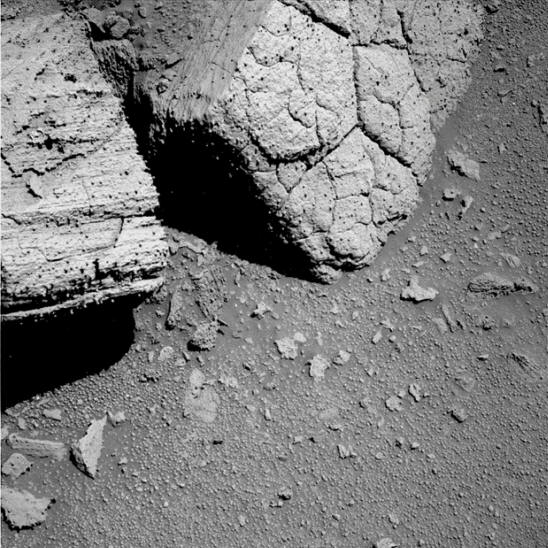New information from the surface
of Mars incites additional questions
about its formation.The Mars
Exploration Rovers (MER) Spirit and
Opportunity have been rolling across
the face of the Red Planet for more
than six years. Opportunity was
launched on July 7, 2003. After a
six month journey, it bounced to a
landing inside a newly
developed airbag system that
cushioned its impact with the
surface of
Meridiani Planum.
Opportunity was meant for no more
than a six month sojourn in the
frozen desert of Mars, but the data
it gathered compelled NASA managers
to continue its mission
indefinitely.
During its many years of travel,
Opportunity has provided a wealth of
information about the topography of
Mars, as well as an analysis of its
chemical composition. The surface of
Mars appears to be rich in silicon
dioxide, otherwise known as
quartzite, and in various iron
oxides, especially hematite.
However, the trillions of tiny
hematite spherules covering the
landing site, labeled "blueberries"
by mission team members, became one
of the first mysteries uncovered by
Opportunity. How they were formed
continues to elude planetary
scientists. They were not called
blueberries because of their color,
since hematite is a dull gray, but
because they resembled blueberries
in a muffin. Most of the sandstone
rocks observed by the rover are
filled with them.
Once again, the MER has
discovered "strange stuff" on Marian
rocks. According to principle
investigator Steve Squyres of
Cornell University, Opportunity has
been studying a 10 meter crater
known as
Concepción for the past
six weeks. An unknown dark gray
material covers some of the rocks
near the
crater's rim. The rocks
also reveal compressed layers of
blueberries in between thin layers
of a different mineral.
Squyres: "It's possible that when
you melt this rock, the sandstone
melts before the blueberries do,
leaving intact blueberries as part
of a melt layer. As an alternative,
we know that this type of rock has
fractures and that the sandstone can
dissolve. Long ago, water flowing
through fractures could have
dissolved the sandstone and
liberated blueberries that fell down
into the fracture and packed
together."
Rather than melted rocks caused
by a meteor strike, perhaps there is
another explanation that can account
for the crater, the hematite
nodules, and the vast fields of iron
oxide dust gathered into immobile
dune-like shapes that lie
on top of hard
quartzite slabs.
Mars is largely composed of iron
and silicon, with massive quantities
of oxygen bound into the soils and
bedrock. The atmosphere on Mars is
of such low density it is sometimes
described as standing on top of a
mountain six-times higher than
Everest, so it lacks the ability to
aggressively attack the Martian
lithosphere.
On Earth, water vapor in the
atmosphere forms a weak carbonic
acid solution when it mixes with
CO2, so that helps to wear away the
rocks. On Mars, such erosion is
impossible for several obvious
reasons, not the least of which is
that there is no open water on Mars
or in its atmosphere.
The presence of iron oxide in
several different forms indicates
that something not taking place on
any large scale today did take place
at some time in the past. When that
past imposed its influence on Mars
depends on which of many
suppositions are considered. Most
Mars research groups speculate that
there was once a dense, oxygen-rich
atmosphere that allowed for the
“rusting” of iron in its crust to
take place.
Others have said that there were
oceans of open water on the surface
that helped to form the hematite
nodules covering nearly a whole
hemisphere (perhaps more). Whatever
the source, Mars has hematite dunes
a kilometer high,
giant cracks that go on
for hundreds of kilometers with
their bottoms covered in hematite
ripples, and seas of
hematite dust tens of
meters deep swallowing craters a
hundred kilometers in diameter
In previous Picture of the Day
articles about the Martian
blueberries, it was suggested that
there might have been some kind of
elemental transmutation on the
Martian surface. Electrical energy,
flowing underground through
selectively conductive materials,
can produce many effects, among them
the change of one element into
another.
In the picture at the top of the
page is a sample of what other
effects might be observed. The
striated and layered quartzite is
sharp-edged and broken into angular
polygons. The fissures running
through them are filled with
hematite dust.
Close up images of the
layered chunks show thousands of
raised nubbins all over
the exterior.
When electric currents of
gigajoule magnitude explode through
rock strata they blast out the
material, forming great trenches.
The debris falls back, creating
piles of distorted and half-melted
minerals with no sign of how they
could have been eroded into their
present appearance.
Conventional theories do not
consider elemental transmutation, so
there are few avenues of
experimentation left open.
Precipitation or chemical
recombination from impact events
appear to be the main arguments put
forward by Mars research scientists,
so their theories about its
evolution are often inconsistent.
Stephen Smith







